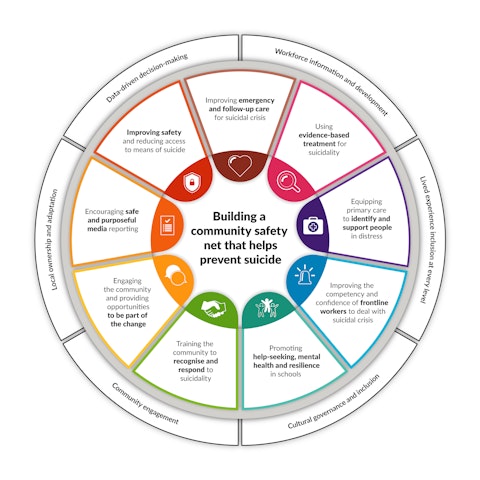LifeSpan Newcastle

What is LifeSpan?
LifeSpan is an evidence-based model for integrated suicide prevention in Australia. Developed by the Black Dog Institute, LifeSpan involved the simultaneous implementation of nine key strategies that have been shown to reduce suicide.
LifeSpan aimed to support people to live full and contributing lives by bringing together healthcare, community services, and those with lived experience within a region, to work collaboratively to implement the multiple strategies within their community.
Strong evidence points to the benefits of combining effective strategies into an integrated approach to suicide prevention. The three key components of LifeSpan included:
- Nine evidence-based strategies, targeting population to individual-level risk
- Simultaneous implementation of all nine strategies in selected regions
- Governance at a local level (integration of non-government organisations (NGOs), primary health care networks, local health districts, education, police and community groups to coordinate action).
The model
The LifeSpan model is evidence-based, and represents current knowledge about best practice in suicide prevention. The new component of the approach which was trialled is the simultaneous implementation of nine key evidence-based strategies within a localised area.
How was LifeSpan delivered?
In 2015, Black Dog Institute received a philanthropic grant from the Paul Ramsay Foundation to allow them to test the effectiveness of the LifeSpan model in reducing suicide attempts and deaths. Four sites within New South Wales were selected to test the implementation of the model. Newcastle was the first site to pilot the integrated approach and commenced in October 2016. It was followed by trials in lllawarra Shoalhaven, Gosford/Wyong and the Murrumbidgee.
Implementation was staged, with one site starting every four months to enable accurate measurements of effectiveness and impact. Each site will have a six month planning phase followed by a two year implementation period.
Evaluation
The evaluation of the LifeSpan trial in NSW consisted of four components and involved comparing rates of suicide deaths and attempts before and after the introduction of the model in each region and comparisons between regions.
There are four layers to the evaluation.
- Primary evaluation: to determine whether there is a reduction in suicide deaths and suicide attempts in communities receiving LifeSpan compared to those who do not receive LifeSpan.
- Secondary evaluation: to determine the intermediate or secondary outcomes associated with the individual strategies including their efficacy and attributed impacts.
- Process evaluation: to determine what aspects of implementation have impacted the outcomes. This will assist in comparing and understanding differences in outcomes between sites implementing LifeSpan.
- Economic evaluation: to determine the cost effectiveness and benefits of LifeSpan. This will allow comparison of changes in rates of suicidal behaviours in LifeSpan sites with the cost of delivering the intervention, minus the costs avoided as a result of averted suicide deaths and attempts.
LifeSpan Newcastle
The LifeSpan Newcastle pilot was led by an alliance of agencies working together locally to prevent suicide, with the contract held by the Hunter New England Local Health District. The partners involved in the Leadership group included:
- Hunter New England Local Health District
- Everymind
- Hunter New England Central Coast Primary Health Network
- Hunter Primary Care
- Calvary Mater Newcastle
- Lifeline Hunter and Central Coast
- Newcastle City Council
- Department of Education
- Awabakal
- members with lived and living experience.
The trial built on collaborative work already occurring in Newcastle between these organisations.
A range of working groups drawing from health, community services, government, education, emergency services, NGOs and the community have been established to plan and deliver strategies locally. The implementation of the LifeSpan model in Newcastle was only possible through the support of the community and other important partners.
Outcomes from LifeSpan Newcastle
LifeSpan Newcastle provided a unique opportunity for the community to come together, consider our existing local suicide prevention efforts, and to use the evidence base to build on and improve this work.
- Read the Life Span Newcastle Final Report








